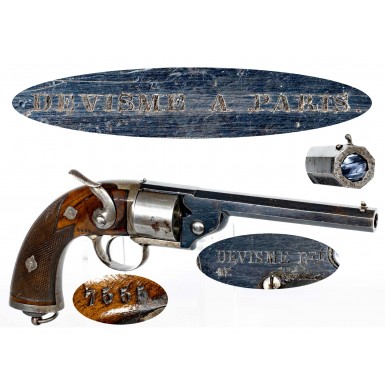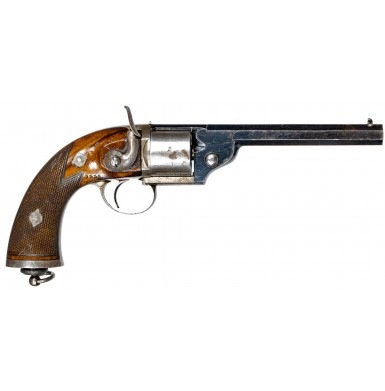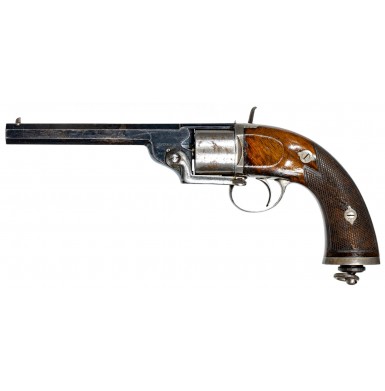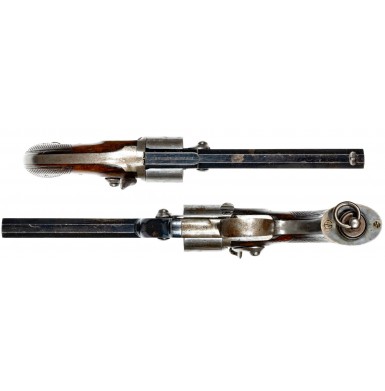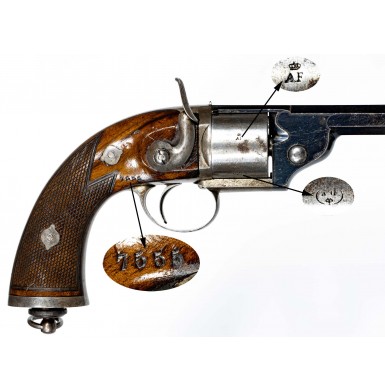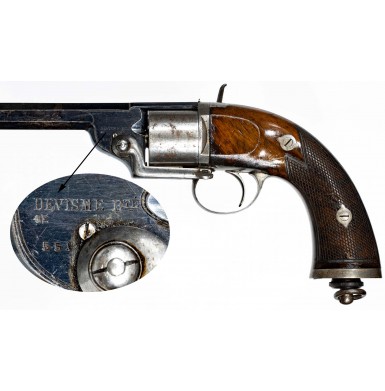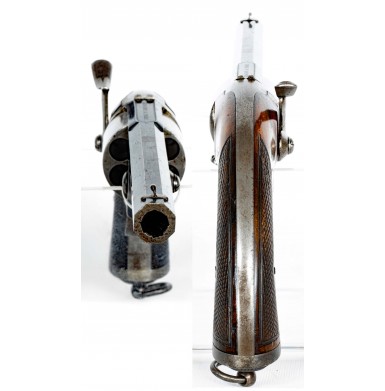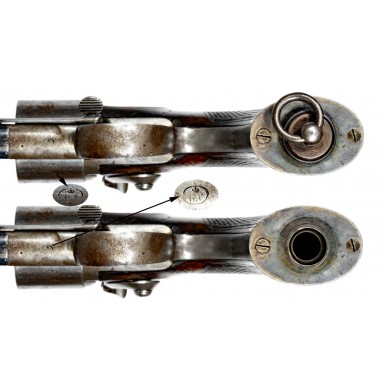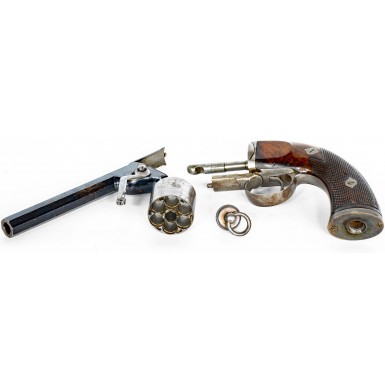Fine & Scarce Devisme Model 1854/55 12mm Cartridge Belt Revolver
- Product Code: FHG-2184
- Availability: Out Of Stock
-
$3,995.00
The firearms produced by Louis-François Devisme (pronounced div-eem) of Paris are among the most highly sought after and desirable arms manufactured during the 19th century. Devisme was an incredibly talented French gunsmith and inventor whose talent and fine aesthetic sense allowed him to produce firearms and swords that were truly works of art. Devisme was born in Paris in 1806 (some sources list his birth date as 1804) and before the age of 30 he had received his first award for firearms design and manufacture at the 1834 Paris Exhibition of Industry. Over the next three decades, Devisme would receive numerous awards and medals for the firearms that he displayed at numerous French Exhibitions, including silver medals in 1839 & 1841 and additional awards in 1855, 1862 and 1867. He also received a medal at the Great Exhibition of 1851 in London (also known as the Crystal Palace Exhibition) for firearms that he displayed there. It is likely that Samuel Colt first became aware of Devisme’s work at The Crystal Palace Exhibition and Colt was apparently impressed enough that he acquired one of Devisme’s percussion revolvers (in unfinished form) for the Colt firearms collection. The pocket-sized percussion revolver of about .28 caliber (7.5mm) is well documented in Colt company records, and the gun (serial #1485) no doubt served as a study piece for Colt and his other designers as well. Devisme manufactured a wide array of firearms from sporting arms like rifles and shotguns to innovative revolvers, single shot pistols and even a “Flobert” type parlor pistol. He introduced a very advanced centerfire revolver in 1858-59, based upon an earlier percussion design and in doing so manufactured one of the first (if not the first) “striker fired” handguns, a concept which is the mainstay of many modern guns designs like those offered by Glock, Heckler & Koch and Springfield Armory. This design allowed for a very low bore axis in the hand, and this meant that the revolver pointed very naturally, was inherently quite accurate and had less felt recoil than other period designs. In many ways, however, Devisme’s innovative firearms designs were really only the canvas upon which he executed his artistry. Exquisitely engraved examples of Devisme firearms are known, often mounted with silver, with chased patterns and high relief embellishments. Devisme’s aesthetic talent rivaled that of the leading French firearms maker of the several decades earlier, Nicholas Noel Boutet. In many ways, Devisme became the “Boutet” of the latter part of the 19th century. Ironically, Boutet died in 1833, only one year before Devisme burst onto the firearms scene with his honorable mention medal at the 1834 Paris Exhibition of Industry. Devisme’s first firearms innovation was a self-cocking revolver patented during the 1830s. By 1854, he had patented a rather unique percussion revolver and he received several additional French firearms patents between 1855 and 1869, culminating with his very futuristic cartridge revolvers. Devisme’s reputation for excellent skill and artistry made his arms highly sought after by the luminaries of his time and have made them equally sought after by the most discriminating collectors of the modern era as well. His quality and artistry resulted in Devisme arms being acquired by the leading monarchs of era, including Queen Victoria, and her consort Prince Albert of England, King Louis-Philippe of France as well as numerous members of the Russian royal household. Some of Devisme’s most famous clients of the era were Confederate leaders, including Generals John Bell Hood, J.E.B. Stuart and Robert E. Lee, not to mention Confederate President Jefferson Davis. Hood, Stuart and Lee all owned Devisme swords, while Davis owned one of Devisme’s high-grade .74 caliber percussion big game stalking rifles, which was captured, along with Davis and his entourage, in Irwinville, GA on May 10, 1865 by elements of the 1st Wisconsin and 4thMichigan Cavalry. In modern times, Devisme’s arms have graced some of the most renowned firearms collections in the world, from the Metropolitan Museum of Art to the finest collection of high grade arms ever assembled, that of the late King Farouk of Egypt.
Offered here is a Devisme Model 1854/55 Belt Sized Cartridge Revolver. Sources vary, and this pattern of revolver is noted as both a Model 1854 and a Model 1855, although these are clearly collector terms of convenience, and it is highly unlikely that Devisme ever referred to these guns by that nomenclature. As the revolver is based upon his 1854 patent, that is probably the most accurate designation for the pistol. The gun is a single action, five-shot cartridge revolver that may well have been altered from its original percussion configuration. The Devisme design was inherently adaptable to cartridge due to the firing system. The revolver has a unique, centrally-mounted, internal hammer that is concealed within the frame, with only the spur exposed along the side of the frame. Variants of this design were produced with both the side mounted cocking lever and a centrally mounted cocking lever. The design is similar to a single action version of the American Pettengill revolver action. As with any standard single action revolver, cocking the hammer rotates and locks the cylinder, indexing a chamber to align with the barrel and sets the mainspring to allow a forceful blow to be delivered to the primer when the sear it tripped. This striker fired system was easily adapted for use with both percussion and centerfire cartridge cylinders. As mentioned above, the design allows the bore of the revolver to sit lower in the hand than other period designs and this translates to improved “pointability”, accuracy, and recoil control. The 6 ½” octagonal barrel is rifled with four grooves that are slightly wider than the lands. The revolver is nominally .41 caliber (or 10.5 mm if you prefer) with the bore measuring about 10.5mm land to land and 11mm groove to groove. The chamber mouths measure closer to 12mm. Much like the Lefaucheux pinfire system, this no doubt results in some disagreement about the caliber of the revolver. As most period cartridge revolvers were referred to by the diameter of the casing, rather than the bore diameter, I think this would be called a 12mm Devisme, rather than an 11mm revolver. While the percussion cylinders incorporated a Thouvenin Tige in each chamber, the cartridge variant has a bore-through cylinder. In America, the bored-through cylinder had been patented by Rollin White who assigned the patent rights to Smith & Wesson. That meant that no company other than Smith & Wesson could produce such a revolver in the United States without paying a royalty to Smith & Wesson. No such limitations were placed upon European gunmakers, leaving them the ability to develop more advanced handguns than were available in the US at the time. The percussion Devisme revolvers used a concave weighted loading piece that was screwed into the butt of the gun. The piece was removed and placed on top of a bullet in the chamber mouth and then struck with a hammer to seat the ball against the tige. This revolver has a removable piece in the butt with a lanyard ring, but the inside face of the piece is flat and not designed for loading the percussion cylinder. Like the percussion revolver, the cartridge gun was loaded by breaking the gun apart and removing the cylinder. This was easily accomplished by rotating a lever mounted along the lower left side of the frame downward. This rotated a half-round lug in the bottom of the barrel wedge and disengaged it from a half-round cut in the bottom of the cylinder arbor pin. Once this cam was disengaged, the revolver could easily be separated into three primary component parts: 1) the barrel, lug and topstrap, 2) the grip frame and 3) the cylinder. The gun was then reassembled by reversing the process. A single guide pin in the bottom of the grip frame and in the top of the top strap assured correct alignment of these two components.
This revolver is serial numbered 7555 on the bottom edge of the right grip, at the frame junction. What I believe to be an assembly number, 551 is present on the right side of the barrel lug. One some guns this number does not appear anywhere else. In this case the number is also found on the interior left edge of the frame under the grip. I am still not sure if this is an assembly number or a patent tracking number related to Devisme’s 1854 patent, a number that assured correct royalty payments. Above the number on the barrel web is the additional mark DEVISME BTE in a single vertical line as well as a {CROWN} / M proof or inspection mark, struck sideways. The {CROWN} / DV within an oval the trademark of Devisme appears on the bottom of the frame, forward of the triggerguard and on both the face and side of the cylinder. A {CROWN} / AF mark appears on the side of the cylinder as well. This is traditionally the mark of Liège (Belgium) gunmaker Auguste Francotte. As the Francotte mark does not appear anywhere else and there are no Belgian proofs on the gun, I believe that Francotte performed the cartridge alteration and created the bored through cylinder for the gun. The topstrap of the pistol is clearly engraved in script:
DEVISME A PARIS.
In my mind, this leaves no doubt as to who the maker of this lovely cartridge belt revolver was. The pistol has three small file slash assembly mating marks that mate the frame, disassembly lever and grips to the gun.
This Devisme Model 1854/55 Cartridge Belt Revolver remains in FINE condition. The frame and cylinder of the gun were apparently color casehardened originally and now have a flecked and mottled lightly oxidized brownish patina over a base steel gray patina. The buttcap retains some strong faded traces of mottled casehardening, maybe as much as 60% of the dulled color. The blued barrel retains about 80%+ of its original blue, with a few minor patches of loss. The blue appears to have worn, thin and flaked to some extent and the exposed metal has developed a smooth plum brown patina. The metal is mostly smooth, with some very light scattered surface oxidation and small patches of lightly scattered roughness, along with some very lightly scattered pinpricking. This is most evident along the lower edge of the topstrap, immediately above the cylinder. This erosive pattern suggests this gun was percussion for at least some period of time. The revolver is mechanically fine and fully functional. The gun times, indexes and locks up perfectly. The bore of the revolver is in VERY FINE condition and remains quite bright with deeply cut rifling with a relatively high rate of twist. The bore shows some lightly scattered surface oxidation along its length, as well as some tiny patches of discoloration. The revolver has a pair of finely checkered walnut grips that are very attractive and add considerably to the overall visual effect of this revolver. The grips double as the side plates for the revolver, and removing them allows access to the revolver mechanism, much like the American Butterfield revolver of the period. The grips are in about FINE condition as well and are free of any breaks or cracks. The grips retain nice, clear and crisp checkering over the majority of their surfaces and remain quite attractive. The grips do show some scattered bumps, dings and light wear marks from handling and use, but show no abuse at all. The original rear sight is present on the top rear of the frame and original the dovetailed front sight is present on the top of the barrel near the muzzle as well, although the barleycorn topped blade is slightly bent. As noted, the butt cap percussion “rammer” for a percussion Devisme is simply a flat faced removable plug with a lanyard ring on the bottom.
Overall this is an extremely fine, attractive example of a very scarce example of the Devisme M1854/55 Cartridge Belt Revolver. The gun remains in wonderful condition and is 100% complete, period and correct in every way. This gun almost certainly dates to between 1854 and 1858 and has survived in very nice, if lightly used condition. It is a historically important revolver when looking at the various mechanisms that were used during the mid-19th century. A revolver of this pattern would a nice addition to any 19th century handgun collection and would fit right in with a Perrin, Raphael and Lefaucheux, all contemporary competing French cartridge revolver designs.
ON HOLD/LAYAWAY
Tags: Fine, Scarce, Devisme, Model, 1854/55, 12mm, Cartridge, Belt, Revolver

